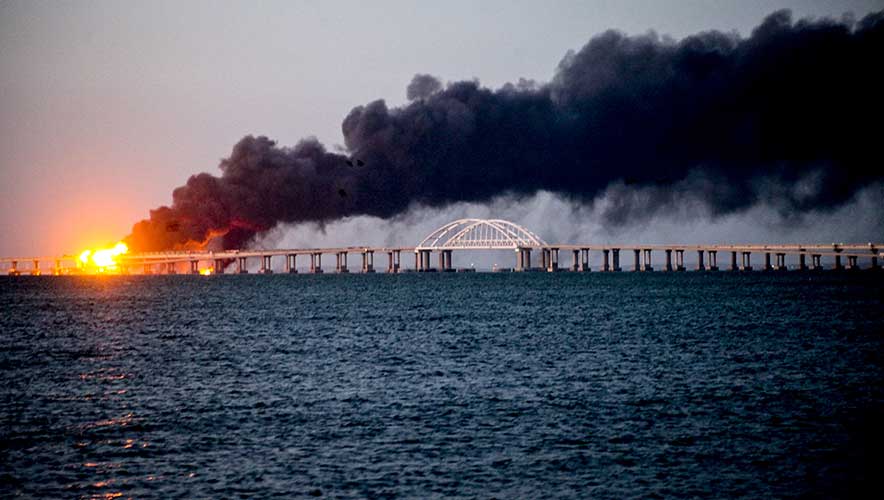Revenge Missile Strikes in Ukraine Send Citizens Back to Bomb Shelters
An explosion on the 12-mile-long Kerch Bridge—which forms an essential link between the Crimean Peninsula and Russia—has damaged the flow of supplies to Russian forces fighting in Ukraine and triggered severe counterstrikes.
The explosion on 8 October was allegedly caused by a truck bomb, and Russian President Vladimir Putin called the blast an “act of terrorism” aimed at a critical piece of Russian infrastructure. Russia illegally annexed Crimea from Ukraine in 2014 and has occupied the region since.
Three people were killed in the explosion, and parts of the bridge partially collapsed. A subsequent Russian investigation led to the detention of eight people in connection with the incident, the BBC reported, including five Russians. The Russian FSB security service said Kyiv was behind the attack, but Ukrainian officials dismissed the charge.
Russia ramped up security on the bridge after the explosion, and authorities worked quickly to reopen two lanes of the bridge to light vehicle traffic.
On 10 October, Russian forces retaliated by launching a wave of missile strikes across Ukraine, including in major cities. So far, more than 20 people have been killed in the attacks, the Associated Press noted. A Russian missile strike on critical infrastructure in the city of Lviv on 11 October left 30 percent of the city without power, Reuters reported. In Kharkiv, three strikes knocked out electricity and the water supply. Russian missile strikes on the southeastern city of Zaporizhzhia left 13 people dead, and a reporter for the BBC said that the buildings struck “are not obvious military targets and the attacks seem entirely indiscriminate.”
Russia’s Defense Ministry claimed that the missiles had targeted “objects of the military command and control, communications, and energy systems of Ukraine” and that “all assigned objects were hit,” CBS News reported. One missile hit a commuter minibus near Kyiv National University, however, and another left a large crater in a children’s playground. The strikes mark the first attack on the Ukrainian capital since June, The Washington Post reported. Approximately 70 sites across the country were damaged, including 29 critical infrastructure sites, 35 private residential buildings, and four high-rises.
Ukrainian citizens in cities further from the eastern front have returned to bomb shelters, stocking up on water, food, and other key supplies to prepare for continued attacks. Subway stations have been designated as emergency shelters for the first time in months.
In response to the increased air attacks, defense organizations from dozens of countries gathered in Brussels to discuss supplying Ukraine with more weapons, including artillery rocket weapons and guided rocket ammunition.
The string of strikes across Ukraine against cities and key infrastructure on Monday has galvanized long-standing calls from the government to its allies for more sophisticated air defense systems and longer range weapons. https://t.co/lGxAmGNCOW
— The Washington Post (@washingtonpost) October 10, 2022
Meanwhile, Germany delivered the first of four ultramodern air defense systems to help protect population centers and large areas from aircraft, missile, rocket, and drone attacks, The New York Times reported. The system is so new that is has yet to be used on the battlefield.
The Iris-T SLM system includes mobile launchers, a vehicle equipped with a 360-degree radar, and a separate command vehicle. According to a spokesperson from Diehl, the company that made the system, it is effective at distances of up to 25 miles and can strike targets up to 12 miles in the air.
